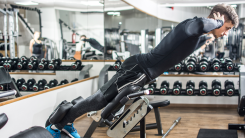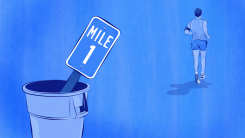The Best Exercises for a Stronger Lower Back

It’s easy to almost forget we have muscles in our back. We can see and feel our biceps and our abs working, but if we ever get a sore lower back, we often worry that we’ve hurt our spine. In fact, there are a ton of muscles back there. We shouldn’t be afraid to work them, and we don’t have to be so weirded out when we feel them working.
One quick note before we get into the explainer and the recommendations: a lot of your favorite exercises already work your lower back. Every deadlift variation, every bent-over exercise (like bent-over rows), and most hinge exercises (like good mornings, especially the seated and arched-back varieties) give the lower back plenty to do. The exercises below are things you might want to do in addition, if you’d like to give your lower back some extra love.
What are your lower back muscles?
There are lots of muscles in the lower back, but probably the biggest group is a family of interconnected muscles called the erector spinae, or spinal erectors. These are two columns of muscle that run down either side of our spine.
If you bend forward and round your back, you’re relaxing your spinal erectors. And when you stand up from that rounded position, those spinal erectors straighten your spine. They’re also the muscles that help us arch our back or tilt our pelvis forward.
And if you’ve ever done heavy deadlifts, you know what it feels like to work these muscles hard. During a hinge movement like a deadlift, you want to keep your back relatively straight (some trainers use the phrase “neutral spine”) even when the weight wants to pull your back out of place. Guess what muscles need to work hard to keep your spine straight? Those same spinal erectors.
So when we talk about lower back exercises, we’re talking about these muscles (and a few others that work alongside them, like the multifidus) that act to extend the spine.
To make sure we’re all on the same page about the movements:
-
Extending or arching your back is the direction you move when you’re bending backwards. Your back muscles are contracting.
-
Flexing or rounding your back is the direction you move when you’re bending forwards. Your abs are responsible for a lot of this movement.
The lower back exercises we’ll be talking about today are the ones where you extend your back. This can mean you start with a neutral spine and arch backwards, or it can mean that you start from a flexed position and extend until your torso is straight.
(Meanwhile, the glutes extend our hips, which is a related but different job. A lot of lower back exercises involve both the glutes and the back muscles.)
Honorable mentions in the bodyweight category:
-
Supermans
-
Glute bridges (on one or two legs)
-
Planks
-
Side planks
Best beginner exercise for the lower back: bird dogs
window.videoEmbeds = window.videoEmbeds || []; window.videoEmbeds.push({
elemId: ‘video-container-QABW99qPiNM’,
data: {“slug”:”QABW99qPiNM”,”start_time”:null,”url”:”https://www.youtube.com/watch?v=QABW99qPiNM”},
videoPlayerType: ‘in-content’
});
The bird dog is the partner to the deadbug, which I included in my post on the best ab exercises. (The deadbug was the beginner-friendly one.)
To do a bird dog, you get on your hands and knees. Then try to raise one arm and the opposite leg, while keeping your back flat like a table. If this is hard, great! There are easier versions of the exercise, and you now have a pathway toward improving: do harder and harder versions until you’re doing “real” bird dogs.
Too easy? You can add some weight with dumbbells and ankle weights, but once you’ve outgrown regular bird dogs, you’ll probably be best off moving to a different exercise.
Best lower back exercise you can do in a regular gym: back extensions
window.videoEmbeds = window.videoEmbeds || [];
window.videoEmbeds.push({
elemId: ‘video-container-BboDheDDH5Y’,
data: {“slug”:”BboDheDDH5Y”,”start_time”:null,”url”:”https://www.youtube.com/watch?v=BboDheDDH5Y”},
videoPlayerType: ‘in-content’
});
Look around your local gym, and there’s a good chance you’ll find a “machine” that is just a strangely angled bench. Anchor your feet and hips against it, and you’ll be able to bend forward at the hips, and raise your torso up and down.
There are several variations of this exercise. Usually people keep their back straight the whole time, aiming to hinge from the hips.
If you come up to a straight position at the top, it’s a “back extension.” If you go even further than that, raising your back until it’s arched, that’s called a “back hyperextension.” Both are great, but make sure you’re choosing the one you want. Aiming for extensions and accidentally doing hyperextensions means you’re not in control of the exercise.
You can do this exercise with just the weight of your body, or you can hug a plate or other weight to your chest.
Best lower back exercise you can do in a powerlifting gym: reverse hypers
window.videoEmbeds = window.videoEmbeds || [];
window.videoEmbeds.push({
elemId: ‘video-container-i9tU7_w7rvw’,
data: {“slug”:”i9tU7_w7rvw”,”start_time”:null,”url”:”https://www.youtube.com/watch?v=i9tU7_w7rvw”},
videoPlayerType: ‘in-content’
});
Powerlifters love a machine they call the “reverse hyper,” which is basically a backwards version of the exercise described above. (Hyper as in hyperextension, get it?)
Legend has it that Louie Simmons, owner of Westside Barbell, invented this machine to help him rehab his back after surgery. It worked so well that the powerlifters at his gym, and a lot of powerlifters today, swear by it as an exercise to keep a healthy back healthy or to rehab an injured back.
Best kept secret: Jefferson curls
window.videoEmbeds = window.videoEmbeds || [];
window.videoEmbeds.push({
elemId: ‘video-container-y_APeWo643w?si=LLOpc5JWR02dV8v1&t=35’,
data: {“slug”:”y_APeWo643w?si=LLOpc5JWR02dV8v1&t=35″,”start_time”:”35″,”url”:”https://www.youtube.com/watch?v=y_APeWo643w?si=LLOpc5JWR02dV8v1&t=35&start=35″},
videoPlayerType: ‘in-content’
});
Still with me? Alright, here at the end of the list is where I like to share an exercise that is lesser-known or that tends to freak people out when they first see it—even though it’s a perfectly fine exercise. (If you saw the pearl-clutching about upright rows in the shoulder exercises post, you know what I mean.)
Today, I’d like to introduce you to the Jefferson curl. It involves rounding your back, which is going to sound dangerous if you’ve absorbed all of the “neutral spine” and “lift with your legs” language of trainers and workplace safety officers. But our backs are able to bend, and it’s healthy and normal to bend them.
Obviously you wouldn’t walk up and try to Jefferson curl 300 pounds your first day in the gym, but if you work up to Jefferson curls with light weight, you may find they’re your new favorite back accessory. (I’ve even had them programmed as part of physical therapy when I had a back injury.)
To do a Jefferson curl, you first bend over, rounding your spine, and feeling a stretch in your lower back. Then you think back to every time you’ve heard a yoga instructor tell you to “roll to standing, one vertebra at a time” and do exactly that.
Add weight by holding a kettlebell, barbell, or any weight you like in your hands. If you’re flexible, you’ll need to stand on a box to give yourself room to get your hands near or even below your feet. I love the way trainer Tasha Louie often does Jefferson curls with a barbell held in the elbows, Zercher style, for more clearance.



